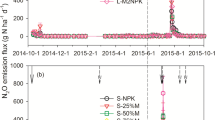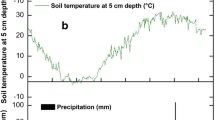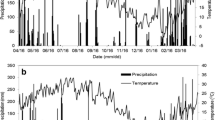Abstract
Guaranteeing high crop yields while reducing environmental impacts of nitrogen fertilizer use due to associated losses of N2O emissions and nitrate (NO3 −) leaching is a key challenge in the context of sustainable intensification of crop production. However, few field data sets are available that explore the effect of different forms of N management on yields as well as on N losses in the form of N2O or NO3 −. Here we report on a large-scale field lysimeter (8 × 4 m2) experiment, which was designed to determine soil CH4 and N2O emissions, NO3 − leaching losses and crop yields from a subtropical rain-fed wheat–maize rotation in the Sichuan Basin, one of the most intensively used agricultural regions in China. One control and three different fertilizer treatments with the same total rate of N application (280 kg N ha−1 y−1) were included: NF: control (no fertilizer); NPK: synthetic N fertilizer; OMNPK: synthetic N fertilizer plus pig manure; RSDNPK: synthetic N fertilizer plus crop residues. As compared to the standard NPK treatment, annual NO3 − leaching losses for OMNPK and RSDNPK treatments were decreased by 36 and 22%, respectively (P < 0.05). Similarly, crop yield-scaled NO3 − leaching for NPK treatment was higher than those for either OMNPK or RSDNPK treatments (P < 0.05). Direct N2O emissions for RSDNPK treatment were decreased as compared with NPK and OMNPK treatments (P < 0.05). Furthermore, the yield-scaled GWP (global warming potential) was lower for the treatments where either pig manure or crop residues were incorporated as compared to the standard NPK treatment (P < 0.05). Our study indicates that it is possible to reduce the negative environmental impact of NO3 − leaching and N2O emissions without compromising crop productivity. Yield-scaled NO3 − leaching, similar to the yield-scaled GWP, represents another valuable-integrated metric to address the dual goals of reducing nitrogen pollution and maintaining crop grain yield for a given agricultural system.





Similar content being viewed by others
References
Aronson EL, Helliker BR. 2010. Methane flux in non-wetland soils in response to nitrogen addition: a meta-analysis. Ecology 91:3242–51.
Baggs EM, Rees RM, Smith KA, Vinten AJA. 2000. Nitrous oxide emission from soils after incorporating crop residues. Soil Use Manage 16:82–7.
Bakhsh A, Kanwar RS, Karlen DL. 2005. Effects of liquid swine manure applications on NO3 −N leaching losses to subsurface drainage water from loamy soils in Iowa. Agric Ecosyst Environ 109:118–28.
Ball BC, Mc Taggart IP, Scott A. 2004. Mitigation of greenhouse gas emissions from soil under silage production by use of organic manures or slow-release fertilizer. Soil Use Manage 20:287–95.
Barnes RT, Smith RL, Aiken GR. 2012. Linkages between denitrification and dissolved organic matter quality, Boulder Creek watershed, Colorado. J Geophys Res 117:G01014.
Bodelier PL, Laanbroek HJ. 2004. Nitrogen as a regulatory factor of methane oxidation in soils and sediments. FEMS Microbiol Ecol 47:265–77.
Cassman KG, Dobermann A, Walters DT, Yang H. 2003. Meeting cereal demand while protecting natural resources and improving environmental quality. Ann Rev Environ Resour 28:315–58.
Ding WX, Cai Y, Cai ZC, Yagi K, Zheng XH. 2007. Nitrous oxide emissions from an intensively cultivated maize–wheat rotation soil in the North China Plain. Sci Total Environ 373:501–11.
Erisman JW, Sutton MA, Galloway J, Klimont Z, Winiwarter W. 2008. How a century of ammonia synthesis changed the world. Nat Geosci 1:636–9.
Grassini P, Cassman GK. 2012. High-yield maize with large net energy yield and small global warming intensity. Proc Nat Acad Sci 109:1074–9.
Harrison J, Matson P. 2003. Patterns and controls of nitrous oxide emissions from water draining a subtropical agricultural valley. Glob Biogeochem Cycles 17(3):1080. doi:10.1029/2002GB001991.
Huang MX, Liang T, Ou-Yang Z, Wang LQ, Zhang CS, Zhou CH. 2011. Leaching losses of nitrate nitrogen and dissolved organic nitrogen from a yearly two crops system, wheat–maize, under monsoon situations. Nutr Cycl Agroecosyst 91:77–89.
Huang Y, Zou J, Zheng X, Wang Y, Xu X. 2004. Nitrous oxide emissions as influenced by amendment of plant residues with different C:N ratio. Soil Biol Biochem 36:973–81.
Hütsch BW. 2001. Methane oxidation in non-flooded soils as affected by crop production-invited paper. Eur J Agron 14:237–60.
Hütsch BW, Webster CP, Powlson DS. 1993. Long-term effects of nitrogen-fertilisation on methane oxidation in soil of the Broadbalk wheat experiment. Soil Biol Biochem 26:1307–15.
Hütsch BW, Webster CP, Powlson DS. 1994. Methane oxidation in soils as affected by land use, soil-pH and N-fertilization. Soil Biol Biochem 26:1613–22.
IPCC. 2006. IPCC Guidlines for national greenhouse gas inventories. Hayama: Institute for Global Environmental Strategies.
IPCC. 2007. Climate change 2007: the physical science basis, contribution of working group 1 to the fourth assessment report of the intergovernmental panel on climate change. Cambridge and New York, NY: Cambridge University Press.
Jones SK, Rees RM, Skiba UM, Ball BC. 2007. Influence of organic and mineral N fertilizer on N2O fluxes from a temperate grassland. Agric Ecosyst Environ 121:74–83.
Ju XT, Xing GX, Chen XP, Zhang SL, Zhang LJ, Liu XJ, Cui ZL, Yin B, Christie P, Zhu ZL, Zhang FS. 2009. Reducing environmental risk by improving N management in intensive Chinese agricultural systems. Proc Nat Acad Sci 106:3041–6.
Kroon PS, Hensen A, van den Bulk WCM, Jongejan PAC, Vermeulen AT. 2008. The importance of reducing the systematic error due to non-linearity in N2O flux measurements by static chambers. Nutr Cycl Agroecosyst 82:175–86.
Li C, Farahbakhshazad N, Jaynes D, Dinnes D, Salas W, McLaughlin D. 2006. Modeling nitrate leaching with a biogeochemical model modified based on observations in a row-crop field in Iowa. Ecol Model 196:116–30.
Li ZM, Zhang XW, He YR, Tang SJ. 1991. Purple soil in China (A). Beijing: Science Press (in Chinese)
Linquist B, van Groenigen KJ, Adviento-Borbe MA, Pittelkow C, van Kessel C. 2012. An agronomic assessment of greenhouse gas emissions from major cereal crops. Glob Chang Biol 17:194–209.
Liu C, Wang K, Zheng X. 2012. Responses of N2O and CH4 fluxes to fertilizer nitrogen addition rates in an irrigated wheat–maize cropping system in northern China. Biogeosciences 9:839–50.
Malhi SS, Lemke R. 2007. Tillage, crop residue and N fertilizer effects on crop yield, nutrient uptake, soil quality and nitrous oxide gas emissions in a second 4-year rotation cycle. Soil Tillage Res 96:269–83.
Meijide A, Diez JA, Sanchez-Martin L, Lopez-Fernandez S, Vallejo A. 2007. Nitrogen oxide emissions from an irrigated maize crop amended with treated pig slurries and composts in a Mediterranean climate. Agric Ecosyst Environ 121:383–94.
Meijide A, Garcia-Torres L, Arce A, Vallejo A. 2009. Nitrogen oxide emissions affected by organic fertilization in a non-irrigated Mediterranean barley field. Agric Ecosyst Environ 132:106–15.
Millar N, Ndufa JK, Gadisch G, Baggs EM. 2004. Nitrous oxide emissions following incorporation of improved-fallow residues in the humid tropics. Glob Biogeochem Cycl 18:1032–9.
Millar N, Baggs EM. 2005. Relationships between N2O emissions and water-soluble C and N contents of agroforestry residues after their addition to soil. Soil Biol Biochem 37:605–8.
Millar N, Robertson GP, Grace PR, Gehl RJ, Hoben JP. 2010. Nitrogen fertilizer management for nitrous oxide (N2O) mitigation in intensive corn (maize) production: an emissions reduction protocol for US Midwest agriculture. Mitig Adapt Strateg Glob Chang 15:185–204.
Miller MN, Zebarth BJ, Dandie CE, Burton DL, Goyer C, Trevors JT. 2008. Crop residue influence on denitrification, N2O emissions and denitrifier community abundance in soil. Soil Biol Biochem 40:2553–62.
Parkin T.B. and Venterea R. 2010. Chapter 3. Chamber-based trace gas flux measurements. In: R.F. Follett, editor, Sampling protocols. USDA-Agricultural Research Service, Washington, DC. www.ars.usda.gov/research/GRACEnet. Accessed 01 Jan 2013, pp. 3–1 to 3–39.
Powlson DS, Goulding KWT, Willison TW, Webster CP, Hutsch BW. 1997. The effect of agriculture on methane oxidation in soil. Nutr Cycl Agroecosyst 49:59–70.
Schellenberg DL, Alsina MM, Muhammad S, Stockert CM, Wolff MW, Sanden BL, Brown PH, Smart DR. 2012. Yield-scaled global warming potential from N2O emissions and CH4 oxidation for almond (Prunus dulcis) irrigated with nitrogen fertilizers on arid land. Agric Ecosyst Environ 155:7–15.
Snyder CS, Bruulsema TW, Jensen TL, Fixen PE. 2009. Review of greenhouse gas emissions from crop production systems and fertilizer management effects. Agric Ecosyst Environ 133:247–66.
Tilman D, Cassman KG, Matson PA, Naylor R, Polasky S. 2002. Agricultural sustainability and intensive production practices. Nature 418:671–7.
Vallejo A, Skiba U, Garcia-Torres L, Arce A, Lopez-Fernandez S, Sanchez-Martin L. 2006. Nitrogen oxides emission from soils bearing a potato crop as influenced by fertilization with treated pig slurries and composts. Soil Biol Biochem 38:2782–93.
Van Groenigen JW, Kasper GJ, Velthof GL, van den Pol-van Dasselaar A, Kuikman PJ. 2004. Nitrous oxide emissions from silage maize fields under different mineral nitrogen fertilizer and slurry applications. Plant Soil 263:101–11.
Van Groenigen JW, Velthof GL, Oenema O, van Groenigen KJ, van Kessel C. 2010. Towards an agronomic assessment of N2O emissions: a case study for arable crops. Eur J Soil Sci 61:903–13.
Vazquez N, Pardo A, Suso ML, Quemada M. 2006. Drainage and nitrate leaching under processing tomato growth with drip irrigation and plastic mulching. Agric Ecosyst Environ 112:313–23.
Vitousek PM, Naylor R, Crews T, David MB, Drinkwater LE, Holland E, Johnes PJ, Katzenberger J, Martinelli LA, Matson PA, Nziguheba G, Ojima D, Palm CA, Robertson GP, Sanchez PA, Townsend AR, Zhang FS. 2009. Nutrient imbalances in agricultural development. Science 324:1519–20.
Wang Y, Wang Y. 2003. Quick measurement of CH4, CO2 and N2O emissions from a short-plant ecosystem. Adv Atmospheric Sci 20:842–4.
Well R, Butterbach-Bahl K. 2010. Indirect nitrous oxide from nitrogen deposition and leaching of agricultural nitrogen. In: Smith K, Ed. Nitrous oxide and climate change. London: Earthscan Ltd. p 162–89.
Yao ZS, Zheng XH, Xie BH, Mei BL, Wang R, Butterbach-Bahl K, Zhu JG, Yin R. 2009. Tillage and crop residue management significantly affects N-trace gas emissions during the non-rice season of a subtropical rice–wheat rotation. Soil Biol Biochem 41:2131–40.
Zavattaro L, Monaco S, Sacco D, Grignani C. 2012. Options to reduce N loss from maize in intensive cropping systems in Northern Italy. Agric Ecosyst Environ 147:24–35.
Zheng XH, Mei BL, Wang YH, Xie BH, Wang YS, Dong HB, Xu H, Chen GX, Cai ZC, Yue J, Gu JX, Su F, Zou JW, Zhu JG. 2008. Quantification of N2O fluxes from soil–plant systems may be biased by the applied gas chromatograph methodology. Plant Soil 311:211–34.
Zhou MH, Zhu B, Butterbach-Bahl K, Wang T, Bergmann J, Brüggemann N, Wang ZH, Li TK, Kuang FH. 2012. Nitrate leaching, direct and indirect nitrous oxide fluxes from sloping cropland in the purple soil area, southwestern China. Environ Pollut 162:361–8.
Zhou MH, Zhu B, Butterbach-Bahl K, Zheng X, Wang T, Wang YQ. 2013. Nitrous oxide emissions and nitrate leaching from a rain-fed wheat–maize rotation in the Sichuan Basin, China. Plant Soil 362:149–59.
Zhu B, Wang T, You X, Gao MR. 2008. Nutrient release from weathering of purplish rocks in the Sichuan Basin, China. Pedosphere 18:257–64.
Zhu B, Wang T, Kuang FH, Luo ZX, Tang JL, Xu TP. 2009. Measurements of Nitrate Leaching from a Hillslope Cropland in the Central Sichuan Basin, China. Soil Sci Soc Am J 73:1419–26.
Acknowledgments
This study was gratefully supported by the Natural Science Foundation of China (Grant No. 41271321), National Program on Key Basic Research Projects of China (Grant No. 2012CB417101), Natural Science Foundation of China (Grant No. 40901144) and the Helmholtz-CAS Joint Laboratory ENTRANCE. We sincerely thank Dr. David Pelster of the International Livestock Research Institute (ILRI) for his help with proof-reading the manuscript. Furthermore, we thank Mr. Zebin Zeng, Dr. Tao Wang and the staff at Yanting station for their support in the field measurements. KBB received financial support via the CCAFS program of CGIAR institutes.
Author information
Authors and Affiliations
Corresponding authors
Additional information
Author Contributions
BZ designed the long-term experiment and KBB, BZ and NB conceived the study. MZ, JB and YW performed the research. MZ analyzed the data and MZ and KBB wrote the paper.
Rights and permissions
About this article
Cite this article
Zhou, M., Zhu, B., Brüggemann, N. et al. N2O and CH4 Emissions, and NO3 − Leaching on a Crop-Yield Basis from a Subtropical Rain-fed Wheat–Maize Rotation in Response to Different Types of Nitrogen Fertilizer. Ecosystems 17, 286–301 (2014). https://doi.org/10.1007/s10021-013-9723-7
Received:
Accepted:
Published:
Issue Date:
DOI: https://doi.org/10.1007/s10021-013-9723-7




